Case Report: 13CA004
Electrician dies when he is crushed between a traveling hoist and a plating tank
Download a PDF to print this report:
Electrician dies when he is crushed between a traveling hoist and a plating tank (13CA004, PDF)
Summary
An electrician died when he was crushed between a traveling hoist and a chrome plating tank. The victim was standing on the elevated catwalk between rows of plating tanks and was most likely leaning over a tank checking on a recent pump installation when the traveling hoist rolled past him, pinning him against the tank. The incident was not witnessed. The hoist operator stated that he was not aware that the victim was in a restricted area (danger zone) between the tanks. The traveling hoist was computer-controlled and moved automatically, and was programmed and monitored by an operator located at the front end of the plating tanks. The safety sensor device on the traveling hoist was designed to immediately shut off when it made contact with an object. However, this device was non-operational at the time of the incident. The CA/FACE investigator determined that in order to prevent future incidents, employers with moving machinery within a restricted work areas should:
- Ensure that moving machinery is inoperable when employee access into a danger zone is required.
- Ensure that emergency safety devices are maintained in operating condition.
Introduction
On Wednesday, March 13, 2013, at 5:30 a.m., a 44-year-old Hispanic male electrician died when he was crushed between a traveling hoist and a chrome plating tank. Notification was received the same day from the Torrance District office of the Division of Occupational Safety and Health (Cal/OSHA). On February 28, 2014, the incident site was visited and the company safety manager, the victim’s supervisor, and other employees were interviewed.
Employer
The employer of the victim was a manufacturer of chrome-plated aluminum automobile wheels. The company has been in business since 1989 and had over 800 employees with worldwide distribution. The facility where the incident occurred had about 100 employees. At the time of the incident, there were approximately 35 employees onsite.
Written Safety Programs and Training
The company had a written injury and illness prevention program (IIPP). The program contained a written policy and procedure for lockout/tagout, but did not include a specific lockout/tagout procedure for the traveling hoist. The company provided and documented monthly safety meetings for employees in both English and Spanish, but training was mostly on-the-job.
The Victim
The victim was a 45-year-old Hispanic male electrician who had been working for the company for ten years. He had an 11th grade education and spoke both English and Spanish. He was born in Mexico and had lived in the United States for the past 14 years. The victim received formal, documented job training and was skilled at the tasks assigned to him.
Incident Scene
The scene of the incident was the chrome plating shop for automotive wheels (Exhibit 1).
At the time of the incident, the operation within the facility was running 24 hours a day. The chrome plating process involved a three-dip procedure consisting of separate vats of liquid nickel, copper, chrome, and rinsing water (Exhibit 2). A computer-controlled hoist with an attached cage for the wheels moved the product through the stages of dipping, and stopped for pre-programmed amounts of time in each vat (Exhibit 3). The hoist was equipped with a safety sensor device that was designed to stop the hoist movement whenever anything came in contact with the device (Exhibits 4 & 5).
Investigation
The victim’s work shift was from 11:00 p.m. until 7:00 a.m. At the time of the incident, the hoist was programmed by the hoist operator to automatically chrome plate a stack of automotive wheels. At approximately 5:30 a.m., the victim entered the chrome plating area through an entrance in the middle of the tank area (Exhibit 6). The hoist operator stated that he was not aware that the victim was on the walkway between the tanks. There were no other workers present in the vicinity of the catwalk or who saw the victim enter the chrome plating area. According to the victim’s supervisor, the victim may have been on the catwalk to check on the prior installation of a pump.
Based on information from co-workers, the victim most likely was leaning over the edge of the tank as the hoist passed by him. The safety sensor device on the hoist was not operational at the time of the incident. As the hoist automatically moved toward the victim, instead of shutting off when it made contact it continued on its path, pinning the victim between the tank and the pipes on the rim of the tank. It is not known why the victim did not get out of the way of the hoist. The hoist operator saw the victim pinned and immediately shut the hoist off and called his supervisor, who called 911. Other employees came to assist and removed the victim by cutting away the pipe. The paramedics transported the victim to the local hospital where he underwent emergency surgery. He was pronounced dead in the operating room.
Cause of Death
The cause of death according to the death certificate was blunt force trauma.
Recommendations
In order to prevent future incidents, employers with moving machinery in restricted areas should:
Recommendation #1: Ensure that moving machinery is inoperable when employee access into a danger zone is required.
Discussion: In this incident, the victim entered a danger zone close to moving machinery while it was in operation. A danger zone is any place in or around a machine or piece of equipment where an employee may be struck or caught between moving parts, or caught between moving and stationary objects or parts of a machine. The danger zone at this scene is the area immediately adjacent to the tanks in the path of the hoist. In this incident, the hoist operator was supposed to stop hoist operation whenever he was notified by or observed an employee entering the danger zone. However, in this case the hoist operator did not observe the victim until he had been pinned by the hoist. Additional mechanisms could be installed that automatically stop hoist operation if an employee enters the danger zone. Such mechanisms could include gate interlocks, visual or auditory warning alarms, or sensing devices that would stop the hoist whenever an employee entered the danger zone. As an alternative, a lockout/tagout procedure would shut down the hoist operation whenever an employee was required to enter the danger zone of crane operation. Had these devices or procedures been in place, the hoist would have been inoperable and the victim would not have been pinned while performing his work tasks.
Recommendation #2: Ensure that emergency safety devices are maintained in operating condition.
Discussion: In this incident, the hoist had a safety sensor device installed on its rail that was designed to stop the crane movement by activating an electrical sensor after contact with an object (such as an employee). Post-incident inspection of the sensor revealed that the local tank atmosphere resulted in sensor corrosion rendering the stop inoperable. Therefore, when the safety sensor device made contact with the victim the crane failed to stop operation.
The employer in this incident did not perform routine inspection and maintenance of the hoist safety sensor device. There was no documentation that the device was tested or deemed operable by company maintenance personnel. It is not known if the victim or hoist operator knew that the safety sensor device was inoperable. Had the safety sensor device on the hoist been inspected and repaired, the crane would have stopped when it made contact with the victim and prevented him from being pinned.
Exhibits
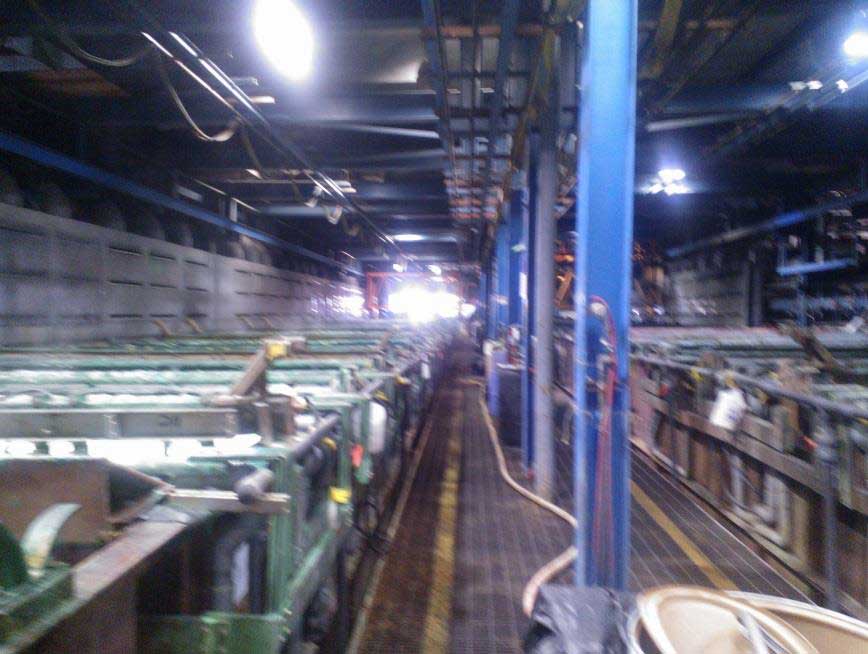
Exhibit 1. The chrome plating area of the business
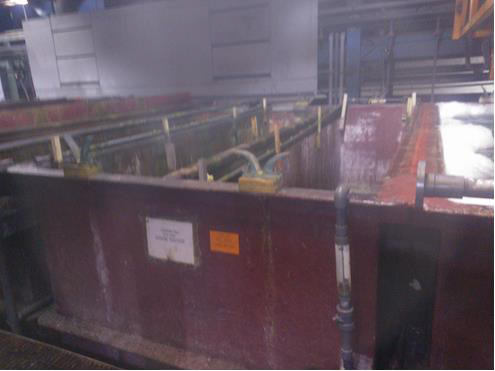
Exhibit 2. The chrome plating tanks.
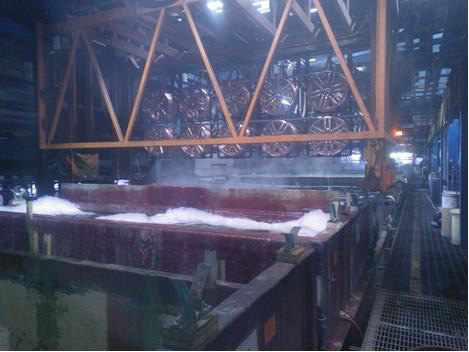
Exhibit 3. The computer controlled hoist with an attached cage for the wheels.
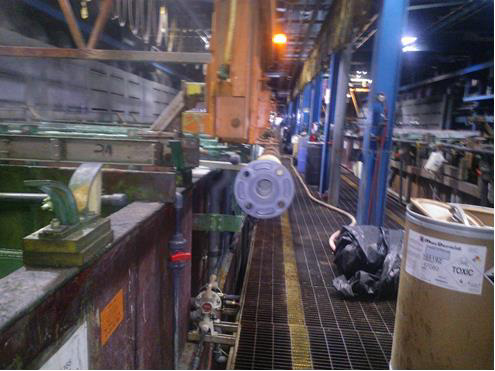
Exhibit 4. The safety sensor device designed to stop the hoist movement when contact is made.
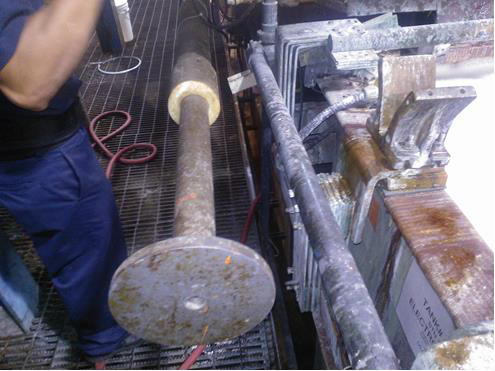
Exhibit 5. Close-up of the safety sensor device.
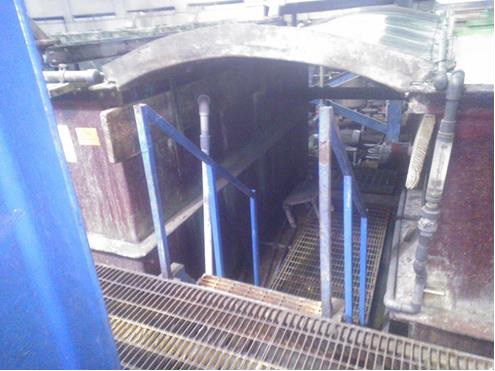
Exhibit 6. The entrance to the chrome plating tanks in the middle of the row.
References
Division of Occupational Safety and Health -Title 8 regulations
Subchapter 7. General Industry Safety Orders
Group 2. Safe Practices and Personal Protection
Article 7. Miscellaneous Safe Practices
§3314. The Control of Hazardous Energy for the Cleaning, Repairing, Servicing, Setting-Up, and Adjusting Operations of Prime Movers, Machinery and Equipment, Including Lockout/Tagout.
§3328. Machinery and Equipment.
Group 6. Power Transmission Equipment, Prime Movers, Machines and Machine Parts
Article 41. Prime Movers and Machinery
§4002. Moving Parts of Machinery or Equipment.
Authors
Hank Cierpich, FACE Investigator
Robert Harrison, MD, MPH, FACE Project Officer
Laura Styles, MPH, Research Scientist
September 15, 2014